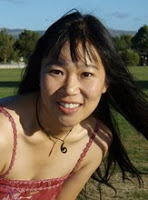
Renee Liang likes to call herself a ‘writer’ as the best description for her disparate activities, which so far include poetry, plays, fiction and non fiction, blogs (for The Big Idea and The Tuesday Poets), librettos and recently, screenplays. She has been part of the Auckland poetry community for a number of years, serving from 2005-9 as a Poetry Live MC. She also organises other arts initiatives focussing on community building and collaborations.
Renee, what impresses me most about your writing – in addition to its quality – is its range. You’re a poet, playwright, short story writer, novelist, and most recently, I gather, a librettist, in the sense that poems from your chapbook Banana have been set to music. How do you organise your life to be able to fit all these things in?
I’m still in a phase of exploration! I’m in love with words and fascinated by stories, and find it very difficult to switch my writing brain ‘off’ (probably a familiar feeling to most writers). I’m always sniffing around, absorbing whatever stories I find and wondering how to best to express them.
I naturally like to experiment with a wide range of writing genres. I think of them as ‘tools’ – much like differently shaped sculptural tools, each genre will bring out a different aspect of story, and each story will have its ideal tool. For example, poetry is perfect to express a concentrated feeling or a single concept, but to explore a longer narrative showing how a character fights with her emotions, I might choose theatre. I’ve found that learning skills in one genre often helps me improve in other genres too.
It’s not that unusual among NZ writers to explore multiple genres over the course of a writing career (or even to change art forms entirely) and the community is small, so it’s easy for poets to meet composers and playwrights to meet filmmakers. People seem willing to share their experiences and secrets and teachers, mentors and collaborators are all very accessible. I’m a huge fan of ‘learning by doing’ and am not too shy about approaching people whose work I admire, so that helps a lot.
And as for how I fit it in timewise… well we all make time for the important things! I find my work as a part-time doctor and researcher fits in well with my urge to write stories. I don’t watch TV if I can help it and unfortunately I don’t have much time for music these days, as I prefer to work in silence, with a clear head. Unfortunately I have an increasing addiction to the Internet so I’ll have to deal with that one somehow.
If some dictator said “You must devote yourself to only one of these forms of writing”, which would it be – or is that an impossible demand to meet?
Pretty much impossible – as I’d want to be free to choose the ‘form’ that I think serves the story best. But poetry is my first love, I find it calms me, and it’s the thing I do most easily.
Banana, which I very much enjoyed, was your third poetry chapbook. Do you plan to keep publishing your poetry in chapbooks, or do you intend to publish collections as well?
I’d love to publish a collection! In fact I put together a manuscript for a poetry collection a few years ago and showed it to someone whose opinion mattered to me and he said (as kindly as he could) that I needed to do quite a bit more work. So while I sharpen my skills, chapbooks are a fun and rewarding way to ‘test’ my work without risking too much!
The next one due out soon is “Toward the Cyclone” – it’s a cycle of sonnets inspired by a study tour to Fiji with a group of other young Pacific leaders, where we met lots of locals, toured industries and villages, and talked with senior leaders.
In the title poem of Banana, you directly address the use of that term as an insult to mean “Yellow on the outside/white on the inside” – and you’ve called your blog Chinglish. Does your being a Chinese New Zealander mean that you are forced to confront these issues of racism and identity whether you want to or not, or did you make a deliberate decision to address them in your writing?
There’s too little time to invest in stories that you don’t care about, and identity is something I find important. Also, I believe that writing grounded in personal reality has power. Being a Chinese New Zealander means that I wear at least one of my identities on my face. Quite often in my daily life I am reminded that I am ‘different’ and it does mean some confrontation – for me if not for my often blithely unaware antagonist! And conflict is good drama, and audiences suck up emotion (and can also tell when it’s not real). So for all those reasons, I’ve found that writing about identity is worthwhile.
Once I started doing that, I found that people identified with my characters – and not just other Chinese Kiwis, but lots of others. It’s a case of the personal becoming universal I guess. Human experience has a lot more similarity than we like to think.
On your blog, you say that one of your top priorities in 2010 will be working on the third draft of your novel. Do you expect this to be the final draft, and what process of revision do you use?
Well, you never know whether it’s your last draft until you are nearly done! That being said, each of my ‘drafts’ so far has contained a significant reworking, often a major structural change or revision of character. I’m still learning what process of revision and rewriting works best for me. I find I tend to micromanage, which affects my progress – so at the moment I am trying to step back and get the larger arcs and themes right before I go for the detail. I’m very lucky to have a wonderful mentor, Siobhan Harvey, who is doing a combination of gentle coaxing and kicking me into action, and gives very valuable feedback.
You are heavily involved in the Auckland arts scene, not least as MC of Poetry Live. In many areas, Auckland seems big enough to be largely self-contained: events unfold there without much reference to the rest of the country. Is this my Wellingtonian viewpoint showing through, or is there some truth in this?
We Aucklanders like to think (and Wellingtonians will be unsurprised at this) that we have the most lively arts scene in the country. This is partly due to size which is in turn partly due to economic reasons – for example, there are lots of actors in Auckland because the TV and film industry is centred here, and so it’s very easy to find people to make new theatre work. But there are also lots of poets, and filmmakers, and musicians… and we are always organising things and meeting each other and talking and hatching new work.
As an example, Poetry Live is an amazing incubator of work, not just poetry, but for music, visual arts, theatre, film, and cross genre. On any night of the week in Auckland it’s possible to find interesting performances or events, and quite a lot of it is free or koha, so it’s a particularly vibrant time to be around. We’re lucky to have great access to venues too – city council and local businesses take the time to build a good relationship with artists, in line with the idea of a ‘creative city’ which Auckland aspires to be.
As for whether we are self contained: Auckland is a bit of a train station. A lot of visiting artists come through from south of the Bombays or overseas, and quite often they perform – for example when I was at Poetry Live we tried to include out-of-town guest poets in our lineup whenever we heard they were in town. Similarly many Aucklanders like going to other centres to show off their work. I usually seek out local poets to meet wherever I travel.
You’ve said that you enjoy working collaboratively, and you did a great job of putting this into practice when you brought your play Lantern to Wellington and got local poets to write poems on paper lanterns which were hung in Bats Theatre’s Pit Bar during the run of the play. Why is working collaboratively important to you?
I find in a good collaboration the whole is much more than the sum of its parts – when you put together two people from different artistic backgrounds but with the same passion and commitment, the project just fires! It’s also good because now there’s more than one ‘driver’ and you can push each other through the rough patches, and also keep one another to deadline (very important in my case).
I also love the way that collaboration opens up whole new avenues of artistic exploration – I gain access to skills I might never acquire for myself, or get pushed into exploring something I might never have done on my own. Generosity and respect are important in a collaboration – the contribution doesn’t have to be equal (although it’s great when it is), but both artists should end up with something they are proud of.
Which authors, playwrights and poets have had the most influence on your writing, or are among your personal favourites?
I’m always discovering new heroes, so my answer to this question is likely to change depending on what I’m reading! That being said, I really look up to Hone Tuwhare as a poet. He seemed to have a knack for finding the emotional heart of things in a playful, unpretentious way – a real joy with words. I’m also a great fan of Chekhov’s plays – they are good, old fashioned, meaty plays, back when playwrights didn’t have to pander to the short attention span of audiences and there was time to really explore the subtleties of character. Of course I’m secretly proud that he was also a writer-physician.
Do you have a plan for how your writing career will unfold? If so, and if it isn’t a secret, where do you see yourself and your writing in five years’ time?
I guess I have the same ambitions as most writers – I’d like to write something which changes the way people think and which lingers in the mind long after. I don’t have a five year plan for achieving this though! I figure that if I listen to my own passions, I’m more likely to write something that I like, and what I find compelling others might also find compelling.
I have no idea what ‘form’ my masterpiece will take either – it could be any genre, or maybe a hybrid! The distinctions between art forms are getting less and less these days. If I’m enjoying myself and feeling stimulated, then I see that as a good sign.


